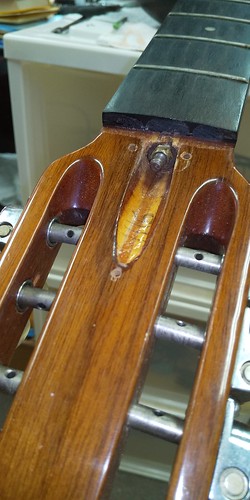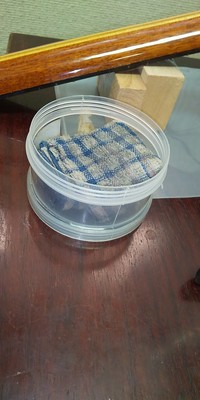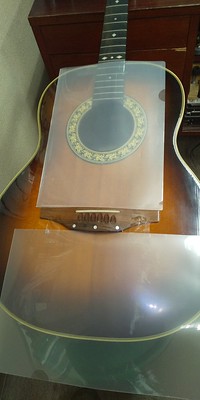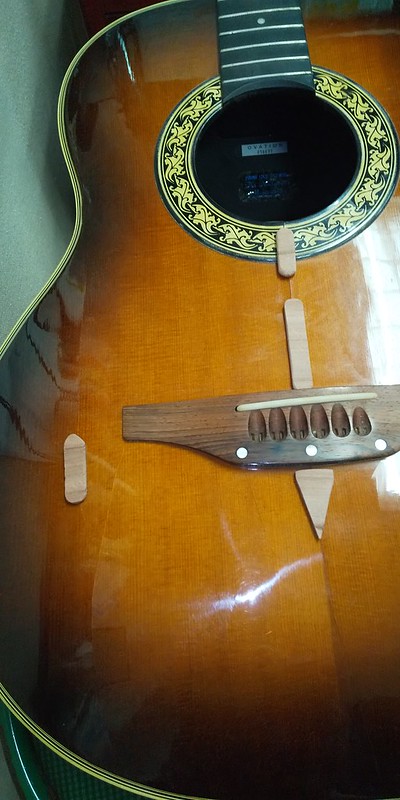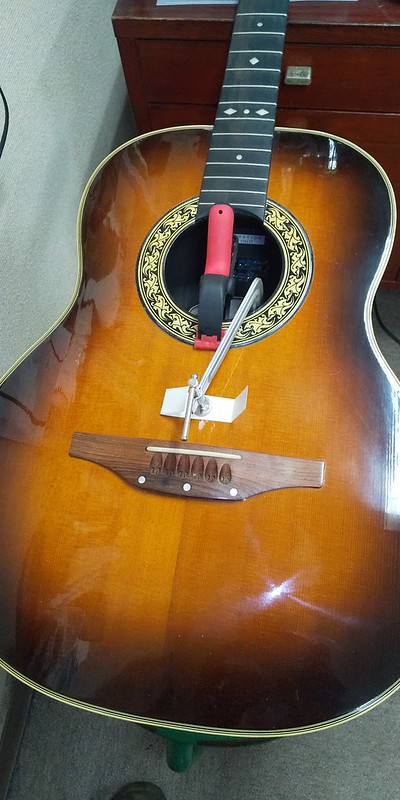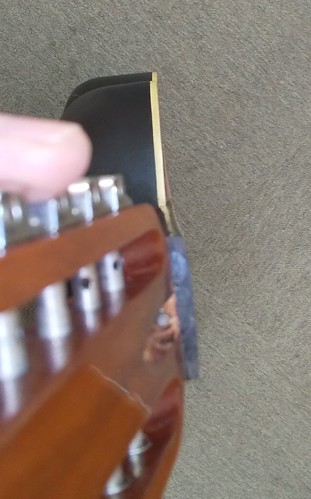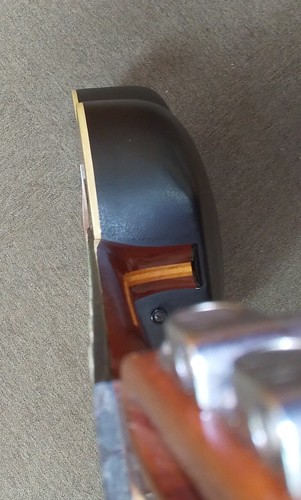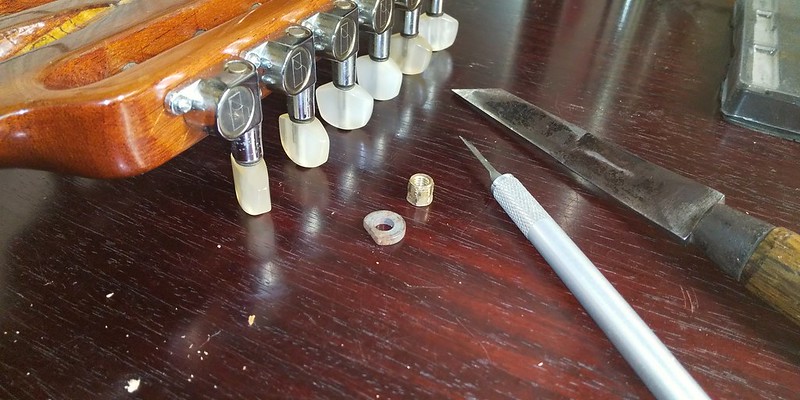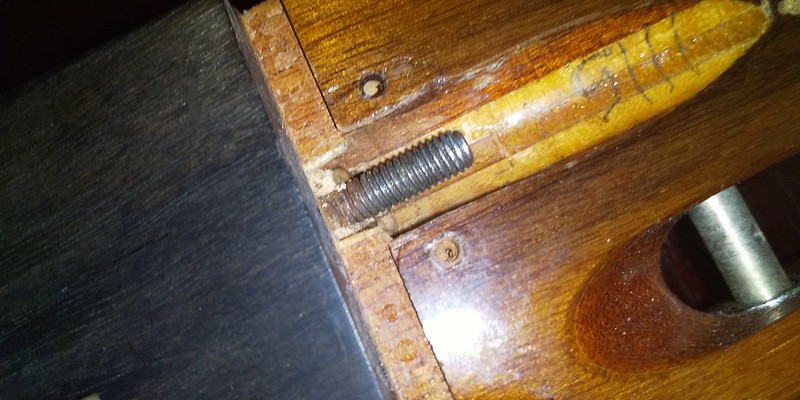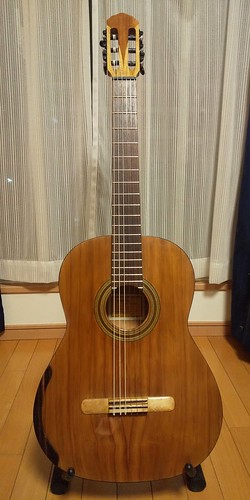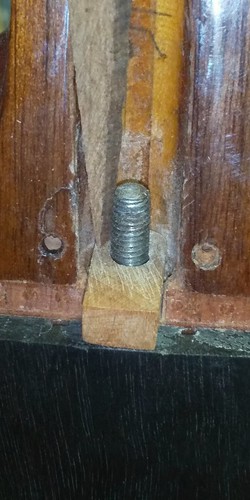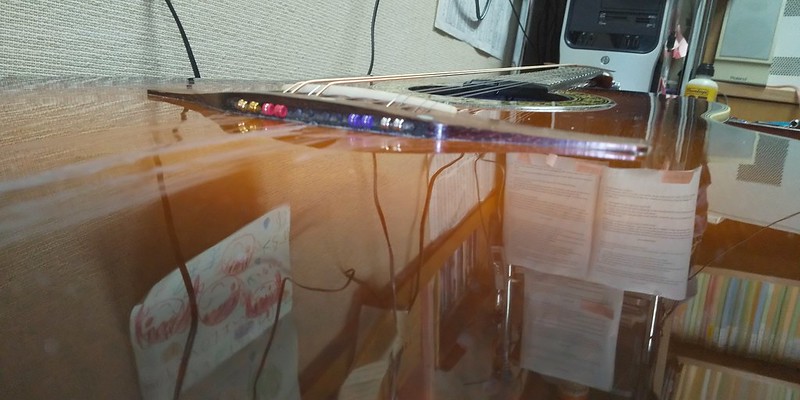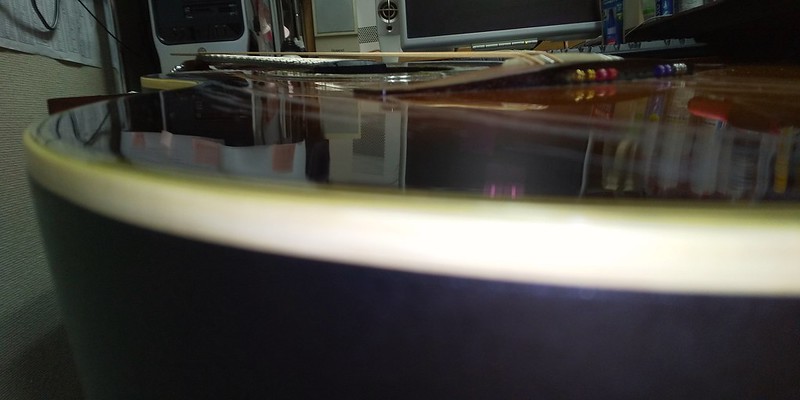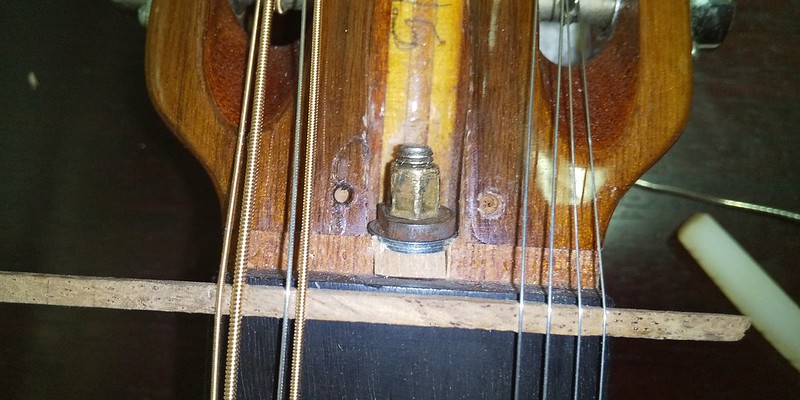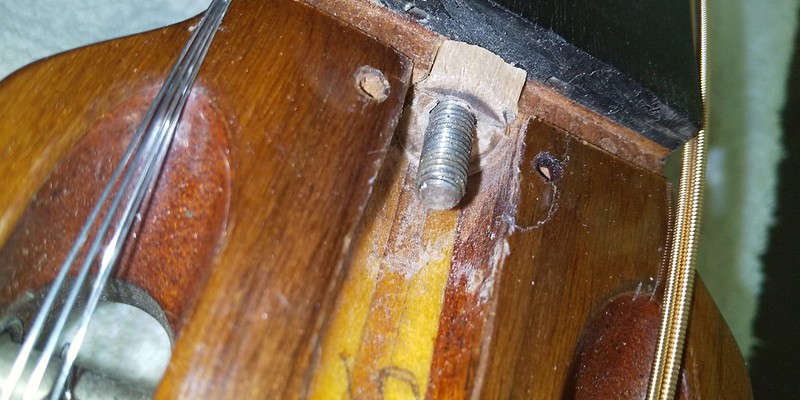|
| ||
| The Ovation Fan Club | ||
| ||
| Random quote: "Ovation Guitars really don't get the respect they deserve!" - Alex Pepiak |
 '74 1115-1 Pacemaker Restoration '74 1115-1 Pacemaker Restoration
| View previous thread :: View next thread | |
| Member Communities -> Bottom Feeding Luthiery Guild | Message format | |
| arumako |
| ||
Joined: October 2012 Posts: 1018 Location: Yokohama, Japan | Hi OFC/BFLG Family! Hope all of you are doing well. It has been a long long time since I've had the chance to check out the OFC, much less post anything. Like many of you, I've been experiencing so many changes over the past year! Fortunately, haven't had to battle COVID myself (yet - fingers crossed); but aging parents, early retirement, moving homes and ensuing carpentry necessities have really kept me running for quite some time. Frankly, I don't know if I'll ever get to the end of this project either, but a bit of breathing space today prompted me to sit in front of my laptop to start this thread about a 1115-1 Pacemaker that I had the fortune of acquiring recently...
With Detlef and TwoWheel going on and on about their twelve strings, I just couldn't pass this up and it's a 12-Fretter to boot! These never come up for sale over here, but I made an offer for roughly $250 bucks (which I never thought would cut it), but here it is. This 1115 has some issues. There are two top cracks that are so common on these older Os (pretty long and go through the wood) that need to be cleated.
The bigger issue is going to be the headstock truss rod adjustment nut. Instead of the 1/4 inch nut stripping the threads on the rod, this nut kept screwing in until the wood area under the string-nut collapsed.
The collapse wood created a steep angle and as the adjustment nut was tightened, the truss rod end began to bend upward. Inside the headstock end of the neck, the bent truss rod began to exert force on the neck behind the string-nut weakening the headstock area of the neck - fortunately the headstock is still holding together.
So, the top will need to be humidified and cleated like seesquare did in his Pandora II thread. The "Vintage 12 String / Truss Rod is Not Hex" thread also showed me what a healthy 1115 truss rod adjustment area looked like enabling me to identify what was happening with this guitar's rod. Need to find a way to bend the truss rod back to the correct angle and rebuild the truss rod adjustment cavity as well as reinforce the underside of the string-nut area of the neck. Don't know how far I'll get, but it's not going anywhere if I don't start so... here we go! Wish me luck. | ||
| |||
| seesquare |
| ||
Joined: November 2002 Posts: 3602 Location: Pacific Northwest Inland Empire | Lemme be the 1st. Good luck! You have some challenges there, but not insurmountable. You may have to make some compromises, though. Like, it may never be safe to maintain "concert pitch", due to the evidenced condition, at present. As you say, just jump into the breach........ | ||
| |||
| MWoody |
| ||
Joined: December 2003 Posts: 13983 Location: Upper Left USA | Sweet project! Keep posting! | ||
| |||
| arumako |
| ||
Joined: October 2012 Posts: 1018 Location: Yokohama, Japan | Thanks for the encouragement seesquare and MWoody - I really missed hanging out here! I get what you mean about not being able to tune to concert pitch. I'll try not get my expectations up too high! So moving forward a bit. Per the Ovation Tribute website's "Ovation Bracing" page here, this guitar has the "Ovation Fan" bracing.
At some point, loose braces were glued down using CA glue, and they are firmly in place. So no need to glue down any loose braces here. The center crack goes down to the middle V area so one of the cleats will need to be shaped to fill the V up to the bridge plate. First, I'll need to humidify the top to close-up the cracks. The entire guitar is terribly dry including the ebony fretboard which is slightly cracked near the sound hole. Gonna use a small round plastic tray with a folded cloth in it (to keep the water from spilling inside the bowl), cover the cracks with plastic sheets, and cover the entire guitar with bubble wrap (to keep the humidity contained) and leave her over night. The water is heated and cooled back down to 75 degrees C (about 170F) and poured into the tray over the towel then placed in the sound hole and positioned under the severest cracked area. If there is too much water or the water is too hot, condensation could occur under the sound board causing water build up and over expansion which in turn will strain the braces or the kerfing so starting very conservatively.
Okay... that's about it for now. Gonna start cutting and carving up the cleats. Planning on making the cleats out of some Pacific Redwood scraps from one of my nylon string re-top projects from yesteryear. Haven't had this much fun in a long long time! Thanks for letting me share on the BFLG! | ||
| |||
| Love O Fair |
| ||
Joined: February 2016 Posts: 1769 Location: When?? | Hi, Ken. Good to see you back on the boards! I was just recently thinking about you and your family, and hope that all is stable and well. It looks like you have a classic trifecta happening on this guitar; though I shall refrain from contemplating good luck as we here never shed a worry that your veteran knowledge and competent skills cannot overtake the challenge to arrive at the most thrilling of victory with no luck required (but good luck anyway.) Looking forward to watching the progress! | ||
| |||
| DetlefMichel |
| ||
Joined: May 2011 Posts: 751 Location: Muenster/Germany | I had a similar tr problem with a 12 string, the screw was too tight and the wood was collapsed behind the saddle. First I removed the screw, and fixed the broken wood. After that I replaced a part of the neck wood with solid ebony, added a metal plate and a metal washer and thus was able to work with the tr. again.
Maybe you could try a similar solution, but I´m afraid you have to go maybe until under the fretboard.
| ||
| |||
| DetlefMichel |
| ||
Joined: May 2011 Posts: 751 Location: Muenster/Germany | ...and...I have 10 12string guitars but 6 of them tuned 1/2 step down and the other 4 1 full step down. Do not tune a 12 string to concert pitch, will not sound better, the high G string will be prone to break all the time and it`s easier to play anyway. Listen to me, I know what I´m doing. | ||
| |||
| moody, p.i. |
| ||
Joined: March 2002 Posts: 15654 Location: SoCal | Actually, I've had an Adamas I 12 string for 27 years. Never a problem tuned to concert pitch...... | ||
| |||
| DanSavage |
| ||
Joined: June 2012 Posts: 2303 Location: Lake Forest, CA | Carbon fiber is a lot harder to warp than wood over time. | ||
| |||
| moody, p.i. |
| ||
Joined: March 2002 Posts: 15654 Location: SoCal | DanSavage - 2023-02-24 1:42 PM Carbon fiber is a lot harder to warp than wood over time. That's a good thing.... | ||
| |||
| arumako |
| ||
Joined: October 2012 Posts: 1018 Location: Yokohama, Japan | @LOF - Thanks Al! It's great to be back. Thanks for your thoughts and your encouragement! By the way, this is my Fxxxxr F330. It's an MIJ all laminate 12-string. Sounded amazing and was my main guitar for about 10 years. Practically used it every week; so, I kept it at concert pitch. One day it refused to stay in-tune as I was playing, and after a few frustrating attempts to keep it in-tune, I realized the neck was beginning to come apart from the body. Removed the strings, and the neck just popped right out of the dove joint. Pretty sure hide glue was used and the glue joint just gave out. It's been disassembled since and is awaiting a new spruce or cedar top. Don't imagine this would ever happen to an Adamas, but anything less...I don't know...
Anyway...hope to finish the easier part of the project today, and get to the truss rod cavity thereafter. Thanks for all the great advice everybody! Be back in a bit! | ||
| |||
| arumako |
| ||
Joined: October 2012 Posts: 1018 Location: Yokohama, Japan | Completed the hydration process by soaking the towel in the round hydration tray twice. The hydration process went very well. Both top cracks are completely back to proper dimensions so all I have to do is glue the cleats in place. Shaped some old low grade Pacific Redwood scraps into cleats. Redwood is very flexible with the grain, but very stiff perpendicular to the grain, and is very very light. They'll provide good support without overly compromising the resonance of the sound board. Here's my cleating plan.
Did a couple of dry runs, and decided to just use Titebond to glue in the cleats.
Worked one cleat at a time by applying the adhesive into the crack from inside the bowl and lightly pushed the cracked area from the outside over and over to let the glue work a little bit into the crack. The straight center cleats were clamped lightly. The V cleat fit snuggly so I just flipped the guitar bowl-side up and put a weight on it while the glue dried. Magnets were used to apply the cleat on the side crack.
Dan always warns against "creeping" when using Titebond, and that's exactly what happened with the side cleat that I clamped with magnets. By the time the glue cured the cleat moved ever so slightly requiring an additional cleat to be applied to the area. No big deal, but I think I could have prevented the creeping by just applying some masking tape over the magnet inside the bowl, doh! In any case, I'll finish the top by applying CA glue to the cracks in the finish and the cracked rosette, scrape and sand the CA glue and re-buff the entire top. But first, I'll need to start work on the truss rod adjustment area of the neck. Fortunately, the neck angle looks good meaning that I won't have to venture into "bowl bending" territory!
Unfortunately, the nut is stuck in there really tight. The usual truss rod wrench is not working, and pliers aren't cutting it either. Need to think about this a bit more before I plunge forward! That must mean it's a good time to stop. Be back in a bit! | ||
| |||
| seesquare |
| ||
Joined: November 2002 Posts: 3602 Location: Pacific Northwest Inland Empire | Significant progress! Doesn't Stew-Mac make a gizmo for cutting around the truss nut? Maybe, it's only for recutting the shoulder after the nut is removed. Dunno. Good advice & note to self to proceed in managable increments. Soldier on! | ||
| |||
| Old Man Arthur |
| ||
Joined: September 2006 Posts: 10777 Location: Keepin' It Weird in Portland, OR | nice stuff | ||
| |||
| arumako |
| ||
Joined: October 2012 Posts: 1018 Location: Yokohama, Japan | Thanks seesquare and OMA!
Cool - perfect fit! After chiseling around the nut and embedded TR washer a bit, got a perfect fit and the nut was off. Got my super thin cutting knife to pry the washer loose and voila!
Grabbed a blank piece of wood to see if I can get the truss rod bent back to the proper position - don't push too hard - easy does it, easy does it - and voila!
Cleaned up the mushed-up maple a bit...
Hmmm...
Now how am I going to rebuild this area? Definitely gonna need more time to think... Better switch gears and fill the top finish cracks with CA glue! Used some high viscosity CA and applied the glue directly onto the finish of the sound board. Gently pushing and releasing the sound board under the cracks to get the glue to work into the finish. The glue seeps into the cracked finish and leaves a bit of a valley, so I keep filling the gaps with glue until all the valleys become mounds. Once the glue is dry, the mounds of CA glue will be scraped level to the finish with an exacto knife blade. The entire top will be sanded and buffed or re-shot with a thin coat of clear poly finish and buffed. The cracks won't be invisible, but the process will discourage the existing finish cracks from extending further.
The last thing before "calling it a day" was applying lemon oil to the bone dry ebony fingerboard. Now, if the truss rod cavity can be fixed properly, this is going to be a beautiful instrument! Better sleep-on-it for now... | ||
| |||
| Love O Fair |
| ||
Joined: February 2016 Posts: 1769 Location: When?? | Two questions for you Master Ken. When hydrating with the cup of 170 F water and cloth you mentioned to begin very conservatively, so did you do that procedure only once to achieve full desired hydration, or have to repeat it? And on the redwood cleats, I cannot see the grain of the cleats in the photos, so I'm not sure if you meant that you should place the grain of the cleats perpendicular to the crack for a tight hold, or parallel with the crack to allow micro flex in tandem with any possible future expansion/contraction of the rest of the top wood. | ||
| |||
| arumako |
| ||
Joined: October 2012 Posts: 1018 Location: Yokohama, Japan | Hey Al! Thanks for the interest. Will send an update on my family by e-mail soon... With regard to the hydration: I had to repeat the process just once. The towel was wetted with warm water and wrung out and placed into the tray. By estimation, I poured about 50ml of hot water in the tray each time over the wet but wrung out towel. The 2nd 50ml went in when the standing water in the tray was gone. At that point, the cracks were still not fully healed. With regard to the Redwood cleats: yeah, grain perpendicular to the cracks. You might remember the Redwood top I used for my heirloom rebuild. I used left over scraps from this top...
This piece of lumber is "low" grade because the grains are not tight like the more sought after stuff that you'll see on Patch's beautiful Redwood O's (but I really love the look and color match with this nylon stringer's maple b/s and neck). That's probably why the grains are not visible to you, but they are there. Also, I wanted cleats that were a bit thicker to withstand the tendency for the top to return to its pre-cleated condition. When I sent my friends Nakao NNS778-9 Elite with a cracked top to the Mother Ship back in 2015, Mr. Budny and gang used some pretty hefty square shaped spruce cleats to make the repair. Thought I'd better not veer to far from what they did. Sorry for rambling on my friend! Edited by arumako 2023-02-26 10:31 PM | ||
| |||
| DetlefMichel |
| ||
Joined: May 2011 Posts: 751 Location: Muenster/Germany | Nice project again, I can feel with you every step. Too bad how some people abuse trussrods, instead of choosing lighter strings or lower tuning. Rebuild the nut area....fortunately the screw is long enough. I used ebony (and tightbond), because I believe wood on wood fits best. You should definetely reinforce this point, but you have easy access, that´s good. And I think you do not need to go further than the fretboard level. I probably would remove the area ca. 1cm left and right from the screw and replace it with a piece of any hardwood and then use the old washer. A little grease on the screw and this should work. That sounds easy, eh?, but when I look at the pictures I´m glad that I´m not at the workbench this time. | ||
| |||
| FlySig |
| ||
Joined: October 2005 Posts: 4025 Location: Utah | Good to see you Ken! Nice work on that 1115. I have an Alvarez Yairi 12 string that I bought in 1977 that's been kept at concert pitch 90% of its life. The neck, action, and top are still as new. | ||
| |||
| DetlefMichel |
| ||
Joined: May 2011 Posts: 751 Location: Muenster/Germany | Seems like I opened a can of worms with my low tunings..;-) | ||
| |||
| arumako |
| ||
Joined: October 2012 Posts: 1018 Location: Yokohama, Japan | I didn't realize 12-string tuning was such a controversial issue, DetlefMichel! Lol! Thanks FlySig! Been itching to get back! Was able to make a little progress on the easier top cracks. The CA glue dried up nicely so I went ahead and scraped the mounds of CA flat. To minimize the possibility of gouging the finish, I use a small piece of an exacto knife and push lightly with the middle of the blade into a convex shape.
The cracks in the finish will still be visible after polishing the finish back to luster, but the cracks have been stabilized, and the top is finished! Now, how am I going to tackle the truss rod adjustment area?
After some thought, decided I needed to make a mock-up truss-rod adjustment cleat out of Birch and test if the truss rod is actually working! Would be tragic to fix everything only to find the rod doesn't work at all! The collapsed area behind the truss rod nut is angled to about 20 degrees to the fret board. The truss rod should be about 10 degrees so, my mock up needs to compensate accordingly.
Really like working with Birch, but the final filler is going to be made of African Black Wood which is considerably harder than Ebony.
I'll drill a hole in the mock up tomorrow, string up the guitar with six strings only, apply some washers and tighten the truss rod nut to see if the relief is eliminated. If it's all on the up-and-up, I'll start working on repairing the truss rod adjustment area. African Black Wood is super hard and brittle so it'll take more time than the Birch mock-up, but just making progress through the project feels good! | ||
| |||
| tpa |
| ||
Joined: December 2004 Posts: 556 Location: Denmark | It is a joy to see you do your magic, Arumako. | ||
| |||
| 2wheeldrummer |
| ||
Joined: February 2014 Posts: 699 Location: moline,illinois | Hi Arumako good to see you back on the forum and working on guitars again,This is for a slightly different kind of repair but have you heard of taping to sides of a razor blade so you can scrape glue without gouging the top,heres a vid where he did it on a drop fill. https://www.youtube.com/watch?v=rTVScFJoe24 WRT to 12 string tuning the old school technique is to tune a 1/2 to a full step down to ease the tension on the top and make it easier to sing,you can always capo up if you want standard tuning,I tune my Adamas to concert pitch because they can handle it but older guitars benifit from tuning down,less like likely to belly and develope high action...Love Your Work So Far!!! | ||
| |||
| arumako |
| ||
Joined: October 2012 Posts: 1018 Location: Yokohama, Japan | Thanks TPA and Twowheeldrummer. So glad to be working on guitars again! Getting to share my progress here is such a privilege! Thanks for commenting! @Twowheel - Yes, I've seen that video and use Dan Erlewine's techniques a lot. He's an enriching resource for sure. For this particular project, the cracks are fairly extensive so I'm planning on sanding down and buffing the entire top. I'm also hoping to thin down the poly finish as they are very thick. Might need to airbrush a thin coat or three of water-based poly before buffing the entire top. Since I'll be rebuffing the whole top a few (or even a lot of) scratches from the exacto knife is not going to be a problem. For what it's worth, I do shorten the exacto blade to minimize any gouging damage that my enthusiastic scrapping might cause. Continued to make a bit of progress today with the truss rod. A 5mm hole was drilled into my Birch mock-up to make room for the end of the truss rod.
In order to ensure a good tight fit I folded some 120 grit sand paper into the truss rod nut slot, and used that as a guide to sand the mock-up into ideal shape.
Also cut around the truss rod cavity under where the nut goes.
Everything fit nicely. The truss rod angle is good so it was time to add the washer and nut. Added two additional washers to ensure I had plenty of threads to tighten the nut. Let the truss rod test begin!
Since the Birch mock-up is in the way of the D and G strings, I strung up the Ee, Aa, bb, and ee strings. These are EJ39 medium gauge strings so they should provide plenty of tension. A thin piece of Koa was laid on the edge of the fret board where a zero fret might go. Notice that the neck has a lot of relief because the tross rod nut hasn't been tightened.
Tightened the strings just a bit (but not tuned), and began to tighten the truss rod nut little by little. Once the truss rod nut was in a fairly tight and standard depth I verified that the relief in the neck was gone. With the neck flat the 8 strings were tuned to concert pitch. The guitar's top was solid and resonated well. The heel of the head stock was in good shape, but the neck bow was back. At this point, the truss rod nut was turned a quarter turn at a time. After each turn, I verified the top and bridges structural integrity, the headstock heel's integrity and the extent of neck bow. At about the sixth quarter turn, the truss rod end started to bend upward this applied pressure to the headstock heel. From here, I had to apply some pressure to the truss rod end to bend it back down after each quarter turn. When the truss rod was bent down, the headstock heel's pressure was relieved and I could make another quarter turn. Wondering if this means the truss rod is bent or poorly installed - not sure, and I sure don't want to take the fret board off to find out!
This is how the neck looked after 11 quarter turns. Interestingly, the nut would have gone further.
For this test the string height is irrelevant as I'm using a koa insert as a temporary nut. The important thing is that the neck is straight from both the bass and treble side of the guitar - which means the truss rod is working! The headstock heel is also holding up although for all practical purposes it will have to be reinforced. Now, check out how far the nut screwed into the truss rod.
This is when I noticed the top of my Birch mock-up was gone! It cracked off and flew silently into the abyss. Notice how the Birch mock-up has been compressed. That is some serious pull force this truss rod is generating! My F330 had super low action and was the easiest 12-string to play, but the truss rod wasn't compressing the wood like this! Birch is very similar to maple in hardness and the 5-ply neck used on this O has maple right where the truss rod's nut applies force. But that's a reality for all Os that have 5-ply necks. So what gives? So I loosened the strings and examined my mock-up...
The birch mock-up insert has been completely crushed. Here's how it looked after I removed it from the truss rod cavity.
I've used Birch for some pretty high-load applications in the past, but I've never seen it obliterated like this! Weird! So the good news is the truss rod is working and the headstock heel is holding up...the bad news is; well, there is no real bad news, but I'm thinking African Black Wood may not cut it. May have to resort to carbon fiber??? Whoa, gonna need more time to think! End of truss rod test! Edited by arumako 2023-03-01 12:01 PM | ||
| |||
| Love O Fair |
| ||
Joined: February 2016 Posts: 1769 Location: When?? | Keep this up long enough and they will eventually give you a license to be a chiropractor. | ||
| |||
| Jump to page : 1 2 3 Now viewing page 1 [25 messages per page] |
| Search this forum Printer friendly version E-mail a link to this thread |
| This message board and website is not sponsored or affiliated with Ovation® Guitars in any way. | |
| (Delete all cookies set by this site) | |






